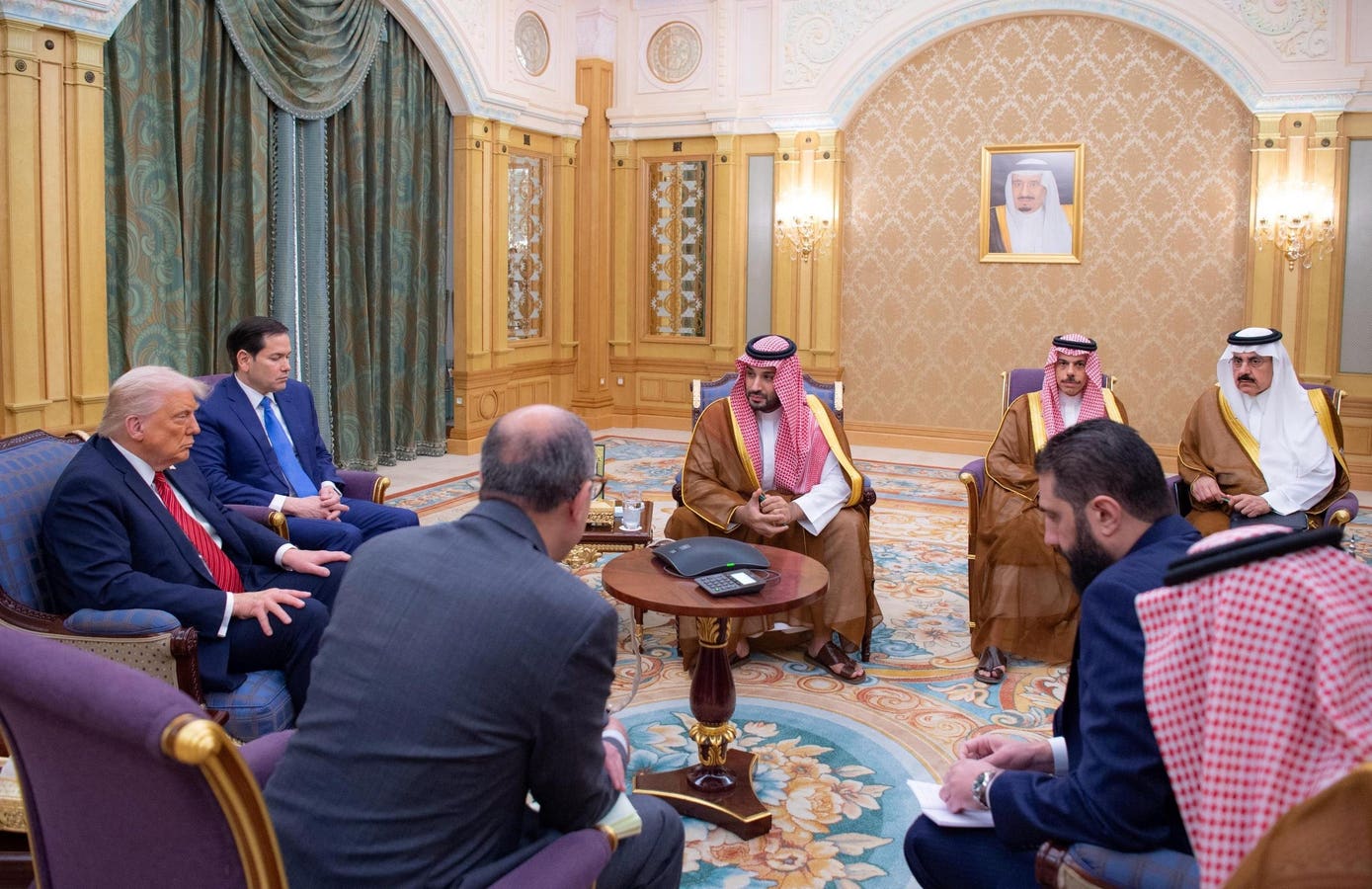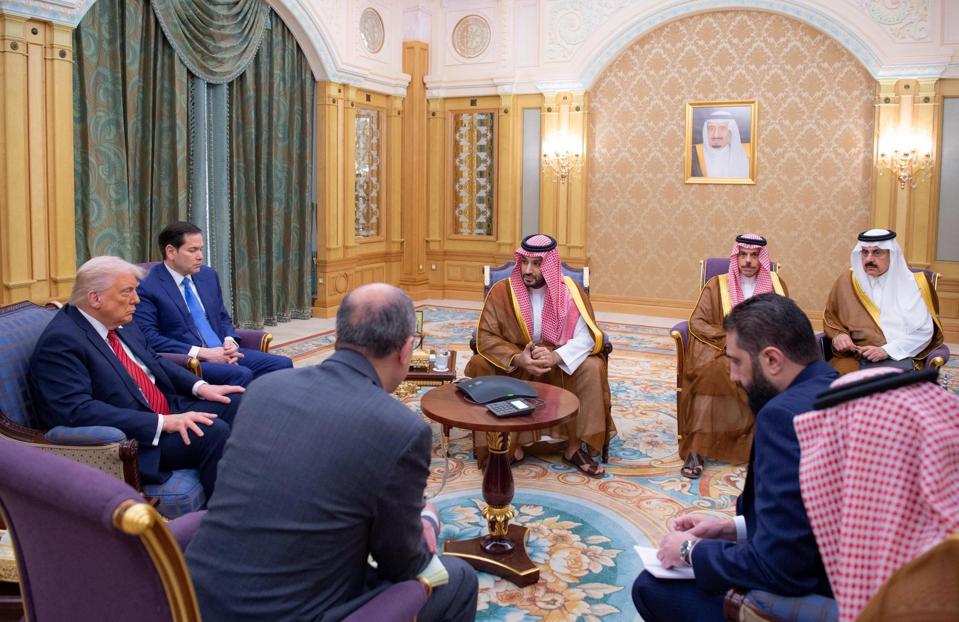U.S. President Donald Trump (1st L), Saudi Crown Prince and Prime Minister Mohammed bin Salman Al Saud (C) and Syrian interim leader Ahmed al-Sharaa (R, front) attend a meeting in Riyadh, Saudi Arabia, on May 14, 2025. Turkish President Recep Tayyip Erdogan joined Trump and Saudi Crown Prince and Prime Minister Mohammed bin Salman Al Saud online during the meeting, Türkiye’s state-run Anadolu Agency reported. (Saudi Press Agency/Handout via Xinhua)
Xinhua News Agency via Getty Images
Profoundly relieved that Syria, after the December 2024 collapse of the Assad regime, broke free of Iran’s orbit, Saudi Arabia is now trying to contain Turkey’s influence in the Levantine nation. Turkey enjoys the advantages of geography and significant military strength but is hampered by serious economic challenges. Leveraging its position as the world’s largest oil exporter, Riyadh seeks to exploit Ankara’s financial constraints to establish itself as a major stakeholder in Syria—and, by extension, in the broader Middle East. Achieving a Saudi–Turkish modus vivendi will be critical to the Trump administration’s objective of managing the Middle East while reducing U.S. exposure to regional instability.”
In an unprecedented move late last month, Saudi Arabia pledged $6.4 billion in public and private sector investments for Syria’s reconstruction. Leading a delegation of roughly 120 government officials and business leaders, Investment Minister Khalid al-Falih traveled to Damascus to attend the inaugural Syrian–Saudi Investment Forum. The two-day event held July 23–24, yielded 47 agreements spanning energy, infrastructure, telecommunications, real estate, agriculture, and banking. Riyadh’s decision to invest—at such scale and in what remains an active battlespace—came just three weeks after the United States lifted sanctions on Syria, a policy shift President Donald Trump announced during his mid-May visit to Saudi Arabia, his first major international trip of his second term.
Saudi Arabia and Turkey form the two pillars of the Trump administration’s strategy for managing the Middle East—an approach rooted in the president’s broader geostrategic approach that allies and partners should take the lead in ensuring the security and prosperity of their respective regions. As the region’s center of gravity, Syria is a country Washington seeks to steer toward stability. This priority was underscored by Trump’s decision to meet with Syria’s new president, Ahmed al-Sharaa—a man who, until 2017, led al-Qaeda in his country. The meeting, hosted by Saudi Arabia’s de facto ruler Crown Prince Mohammed bin Salman (MbS) and attended virtually by Turkish President Recep Tayyip Erdoğan, reflected the high stakes and regional coordination driving U.S. policy.
Under Erdogan, Turkey has long supported different Islamist factions to further its strategic interests, especially the goal of countering Kurdish separatism on its southeastern periphery. Ankara has actually had close ties with Sharaa’s ruling Hayat Tahrir al-Sham (HTS) since its inception in 2017. For Saudi Arabia, however, this marks the first time it has supported a government dominated by an Islamist movement. The magnitude of this policy shift is highlighted by the fact that Riyadh had fully restored diplomatic relations with the now-ousted Assad regime just three months before its overthrow by HTS.
Several factors explain this dramatic shift. First, Riyadh had not anticipated the Assad regime’s collapse as a byproduct of Iran’s weakening in its conflict with Israel. In fact, even as Iran and its premier proxy, Hezbollah, were being eroded through much of 2024, the Saudis appointed their first ambassador to Damascus in 12 years—capping a year-long diplomatic process that included former President Bashar al-Assad’s visit to Riyadh in May 2023. In a sense, by normalizing ties with Syria, the kingdom was fortuitously positioned to engage with the new HTS-led government.
Second, and more strategically, the Saudis were keen not to miss the historic opportunity presented by regime change in Damascus, which effectively ended Iran’s domination of Syria. Riyadh sought to capitalize on the moment and secure its northern flank, long overshadowed by Tehran’s contiguous sphere of influence. Third, Turkey was far better positioned to benefit from Syria’s detachment from Iran. Its extensive southern border provided Ankara with a significant advantage, allowing it to fill the vacuum left by Tehran’s receding presence.
With 20,000 troops and tens of thousands of allied militiamen, Turkey has controlled significant swathes of territory across five northern Syrian provinces since 2016. This forward deployment allowed Ankara to provide critical military and intelligence support that enabled HTS to overthrow the Assad regime. Today, Turkey is taking the lead in shaping the post-Assad Syrian state, particularly by directing the development of its armed forces. Nonetheless, Ankara’s economic fragilities—soaring inflation, a volatile currency, mounting debt, and a weak financial sector—severely constrain its ability to contribute meaningfully to reconstruction in its war-torn southern neighbor.
The Turks understand that for their Syrian allies to consolidate power in Damascus, they must demonstrate tangible progress in rebuilding Syria’s infrastructure and restoring essential services. This is a Herculean task, given that international assessments estimate reconstruction costs in the hundreds of billions of dollars, leaving Ankara little choice but to seek Saudi assistance. From Riyadh’s perspective, this presents a strategic opening to limit Turkey’s influence over the emerging Syrian state. By leveraging Turkish dependence on the kingdom and other wealthy Gulf actors such as the United Arab Emirates, Saudi Arabia can construct a bulwark against Ankara’s ambitions to assert itself as the region’s dominant power.
This imperative is shaped by a long history dating back to the 18th century when the first Saudi state was established in the mid-18th century after MbS’ ancestors rebelled against Erdogan’s Ottoman forebearers. The Ottomans were able to dismantle the first and second Saudi states in 1824 and 1891 respectively but their own empire collapsed at the end of World War I by which time the Saudis were on their way to staging a comeback in the form of the current modern kingdom. By the late 20th century, Turkey had become a major military and industrial power, while Saudi Arabia leveraged vast oil reserves to emerge as a global financial heavyweight, setting the stage for both nations to assert themselves as major powers.
The two nations, however, did not embark upon the path towards strategic competition until the Erdogan regime in the late 2000s began to reorient Turkey from the west and towards the Middle East. This shift was shaped by three decades of upheaval—the collapse of the Soviet Union, the September 11 attacks, and the Arab Spring. Iran’s arc of influence extending westwards from the Zagros Mountains to the Eastern Mediterranean, however, continued to serve as a buffer between the Turks and the Saudis. Until last year, when the destruction of Hezbollah’s offensive capabilities in Lebanon, which led to the ouster of the Assad regime, brought them face-to-face with one another in Syria.
Despite their domestic constraints, both countries view Syria as a strategic priority. The Saudis lack the military and strategic capabilities to match Turkey, while Ankara does not possess the financial leverage Riyadh can wield. These complementary strengths compel the two to cooperate in pursuit of their objectives in Syria. They also share the goal of preventing an Iranian resurgence while ensuring that Israel’s security concerns do not derail their mutual aim of stabilizing the country.

